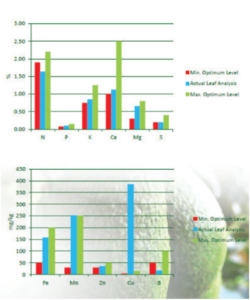Written by Jaques Landman Director & Technical Manager at Agri Technovation New Zealand
Nutrient deficiency or excess will cause trees to grow poorly and produce sub-optimal yields and/or poor fruit quality. For this reason, diagnosis of potential nutritional problems should be a yearly routine for fruit-growing farmers. Quantifying nutrients in soils and trees (leaf testing) eliminates assumptions when adjusting a fertilizer program.
Leaf sampling:
Leaf analysis enables us to directly measure the nutritional status of trees. The results can then be compared with known standards to determine whether the tissue contains excessively high or low concentrations of critical macro and micro-nutrient elements. The nutrient supply can then be adjusted to bring the levels of the mineral nutrients in the tissue back to within acceptable limits.
Leaf analysis has several advantages:
- An exact picture of the nutrient content at any given time is provided, from which correlations with production can be drawn.
- In a fruit, all essential nutrients are in. The presence or absence of individual nutrients in soil samples may not be related to the total quantity of those nutrients available in the fruit tree.
- Leaf analysis helps in understanding the internal functions of nutrients in each fruit crop.
- Identifies hidden toxicities and deficiencies when visible symptoms are not present.
- One can distinguish between nutrients which have similar deficiency symptoms.
- Evaluates the effectiveness of fertilizer programs and provides a way to compare several fertilizer treatments.
How should leaf samples be taken?
Leaf sampling should be carried out annually/biannually and must be done correctly if a reliable result is to be obtained. Since the levels of most elements in the leaves change during the season, it is important that leaf sampling should be carried out at the correct time.
For most deciduous tree crops, leaf analyses are usually done between February – April. Leaf samples and soil samples are preferably taken at the same time, per phenological stage of each crop. Wherever soil classification maps are available, leaf samples should preferably be taken as representative of the specific soil types.
The following information must accompany the samples:
- Owner’s name and surname
- Farm name and postal address
- Orchard name or block number
- Fruit kind and cultivar
- Age of orchard
- Vigour of trees
- Estimated yield in the next season


This information is essential for the interpretation of the analytical results and for the formulation of recommendations. The accuracy of the recommendations will depend on both the extent to which the sample is representative of the orchard and on the accuracy of the information that is supplied. No recommendations can be given if this information is inadequate.
Soil chemistry (soil sampling):
Soil chemistry provides answers to the producer’s soil nutrient status opportunities and risk before the start of a season. Conducting precision-based soil chemical analysis on a pro-active basis also identifies specific areas where certain nutrient corrections need to be made. Crops are usually grown on a very wide variety of soil types which all have different fertilizer requirements, depending on the soil health and condition.
Why should soil sampling be done?
- To gain knowledge about the soil condition and how to improve it.
- It is the first step into soil fertility management.
- To minimise fertiliser expenditures.
- To avoid over-fertilisation.
- To avoid soil degradation.
Soil analysis is helpful in formulating and improving a fertilization program as it measures the pH and extractable nutrients. When conducted for several consecutive years trends in the soil chemistry can be observed. The single most useful soil test in an orchard is for pH. Soil pH greatly influences nutrient availability. Some nutrient deficiencies can be avoided by maintaining soil pH between 5.5 and 6.5.
A grower cannot rely on soil analysis alone to formulate a fertilizer program or to diagnose a nutritional problem in an orchard. Leaf sample analysis and observations of leaf deficiencies and toxicities should also be used.

Figure 1: Map example with the interpretation of leaf/ soil analysis.
Conclusion:
Leaf and soil analysis are powerful tools to confirm nutrient deficiencies and toxicities, identify “hidden hunger” (a situation in which a plant needs more of a given nutrient yet shows no deficiency symptoms), evaluate fertilizer programs, study nutrient interactions, and determine fertilizer rates. However, if any steps in site selection, sampling or analysis are faulty, the results may be misleading. Tree age, cropping history, sampling techniques, soil test interpretations and leaf analysis standards all must be considered before making a final recommendation. If done properly, leaf and soil analysis will lead to a more economical and efficient use of fertilizers.

Let Agri Technovation help you with your soil and leaf analysis:
We send our Field technicians to your farm to UNDERTAKE ALL THE SAMPLING FOR YOU. Sampled areas are marked with a GPS device.
Hereafter, Agri Technovation will integrate individual samples and create maps with the interpretation of leaf (tissue) analysis which willinclude the ratios between nutrients and the possible corrective recommendations (Figure 1). Soil samples are taken according to a map grid on existing or planned orchards, fields and/or net houses. All samples are sent to an accredited laboratory for a standard soil analysis. The laboratory results are processed and transformed to GIS maps. Soil chemical maps contain approximately 30 individual maps and includes a topographical map.

